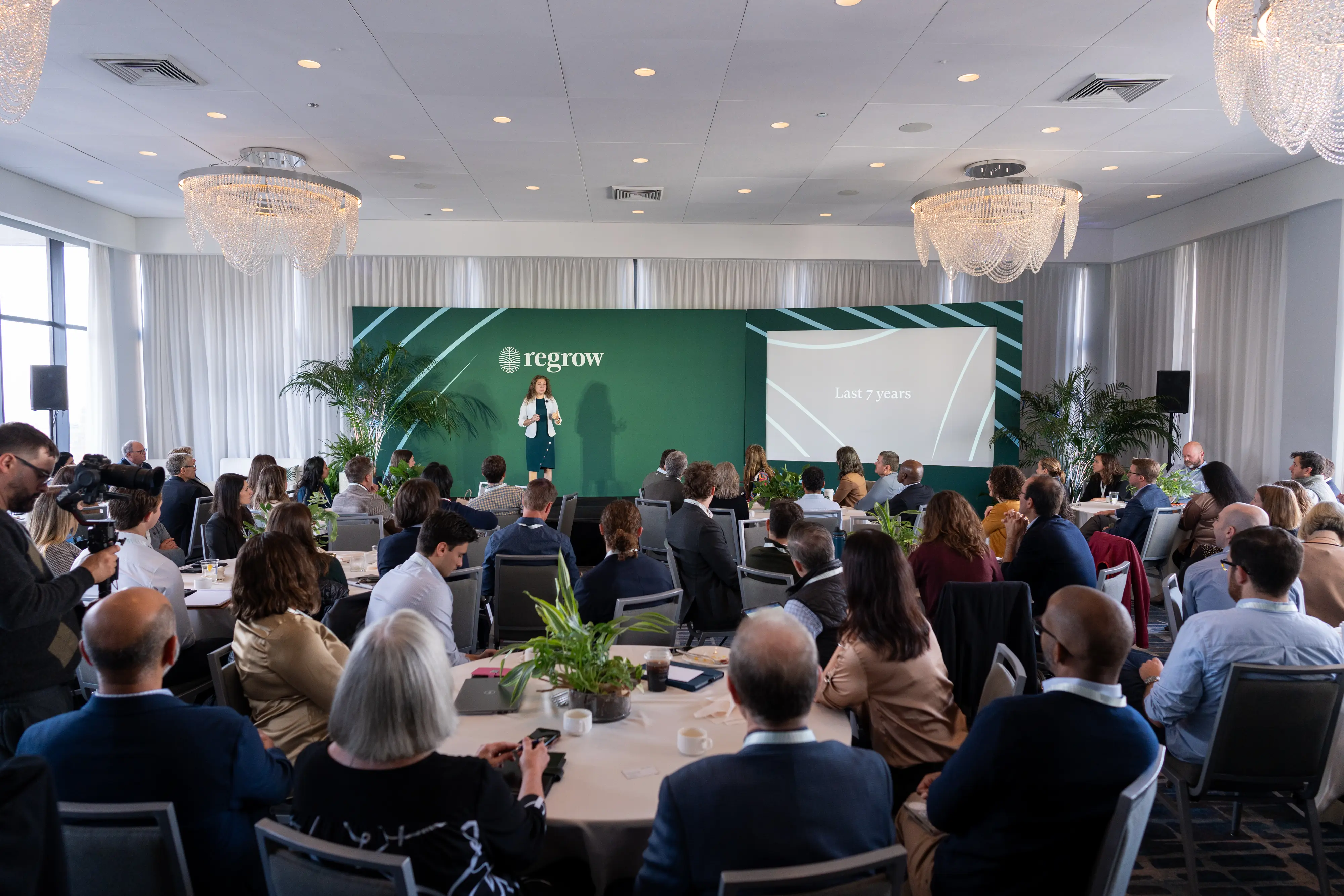Conversations at Regrow’s Agriculture Resilience Summit centered around the theme of accelerating impact.
When it comes to agricultural production, the next 7 years cannot be like the last.
In 7 years, we’ll be staring down the end of 2030 — the year when many corporations and governments have set climate action and emissions reduction commitments. Collectively, we have a lot of work to do in order to meet our goals.
However, in the last 7 years we haven’t seen as much progress as we’d hoped. In agriculture, sustainable practice adoption has been, “at best, stablish” — according to Regrow CEO Anastasia Volkova in her keynote address.
That’s why it was essential for industry leaders from across the agrifood supply chain to gather in Chicago this week, to realign ourselves towards our climate goals for 2030 and beyond.

Over two days, summit attendees collaborated on strategies to enhance the sustainability and resilience of our agricultural practices. While the specific details of these discussions remain confidential under Chatham House Rules, three central themes emerged from the summit that deserve continued conversation.
Collaboration across the value chain is the key to accelerating action and impact
Collaboration is the key that unlocks acceleration and propels us toward our shared goals. Conversations between growers, CSOs, sustainability and procurement practitioners, researchers and policymakers showed us that building a sustainable and resilient food system requires a unified effort.
This collaboration was particularly visible in conversations among early adopters who worked to find common goals and opportunities in climate action. Attendees explored innovative solutions that catered to the diverse needs of multiple stakeholders and highlighted the importance of each stakeholder’s role in nurturing resilience. For example, during a working session one global CPG company discussed the possibility of developing a water quality project with a fourth-generation farmer, supported by a leading research organization. Other companies discussed the benefits of pilot projects in guiding the future of climate programs.
Collaboration fosters a broader perspective, enabling collective investment in programs, shared costs, and responsibilities, and knowledge sharing.
Beyond pencil farming: resilience begins with the farmer
While it's essential to build strategic plans for resilient farming, it's equally important to test these plans with producers, implement programs that are agile, and understand that what may work on paper doesn't always translate to real-world farming. This concept — planning for farming practices on paper, without experiencing how those practices come to life on the field, with nuanced weather, soil and cropping systems, was coined “pencil farming” by one of the Summit attendees.
Conversations at the Summit emphasized the significance of taking ideas off paper and into the real world — and thus placing the farmer at the heart of our efforts to scale resilience across all aspects of the value chain.
Not only are farmers the engine of our food systems, but their insight is essential for us to scale sustainable food systems. The nuances of farming practices vary in different ecosystems, and these variations must be accounted for in program development. While many programs are focused on supporting growers, we need to ensure that our system (guidance, policies, corporate-led programs and research pilots alike) is built in a way that promotes practice adoption through well-rounded support for growers.
For example, one farmer told a story of a drought in his region one year, and a flood the next year. These two extreme weather events disrupted his crop rotation, which made him ineligible for some of the conservation programs he’d planned to join. Programs that account for weather events, changes in a farmer’s ecosystem, and other factors would have allowed the farmer to make the adjustments he needed on his operation, and continue to employ conservation practices.It is our shared responsibility to streamline programs and incentivize the adoption of climate-smart practices in ways that support farmers first. With a shared commitment to fostering resilience, we can collectively work towards a sustainable future.
Systems thinking for effective climate action
Our food systems are among the most complex on Earth, influenced by a myriad of factors and stakeholders. They are influenced by the weather, rural communities, geopolitics and our global economic systems. They touch every aspect of our lives, and their health indicates the health of our people and planet.
The summit urged participants to transcend their silos and consider external factors affecting climate and food production.
The focus was on building a system that not only functions effectively today but also paves the way for accelerated progress in the future. In bridging the gap between our climate ambitions and the current state of progress, we must transition from linear thinking to exponential thinking. This requires radical collaboration, a transformative approach that has the potential to reshape the agricultural system as we know it.
The future of our food systems depends on resilience
The Agriculture Resilience Summit brought together a dynamic community of experts, visionaries, and passionate individuals who have sparked vital conversations and opened up new pathways for building agriculture resilience.
These themes—collaboration, farmer-centric strategies, and systems thinking—serve as the foundation upon which we can collectively work towards a sustainable and resilient food system. While the summit's specific discussions remain confidential, the insights gleaned from these key themes provide a roadmap for future endeavors in the pursuit of a more sustainable and resilient future. We look forward to further exploration and development of these ideas as we move into the next era of agriculture.
Explore agriculture resilience at resilience.regrow.ag.



